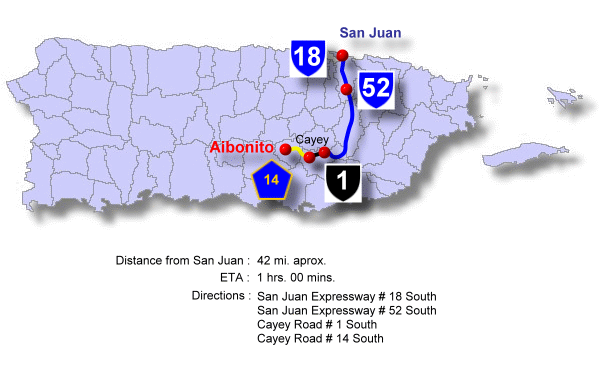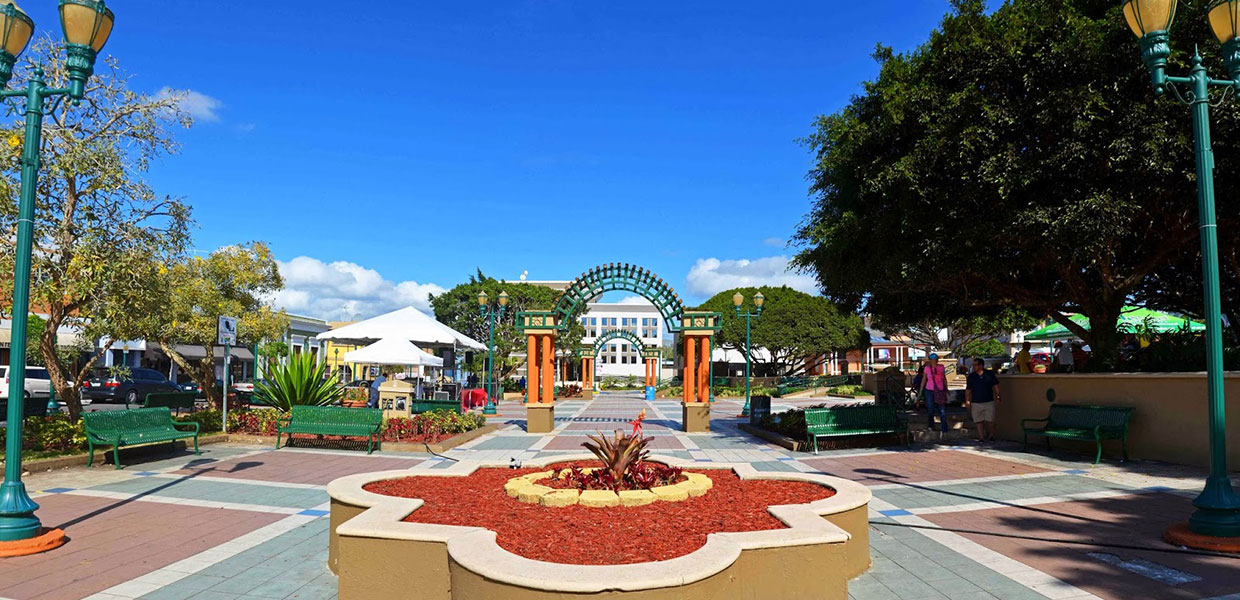
Aibonito, Puerto Rico
City Of Flowers
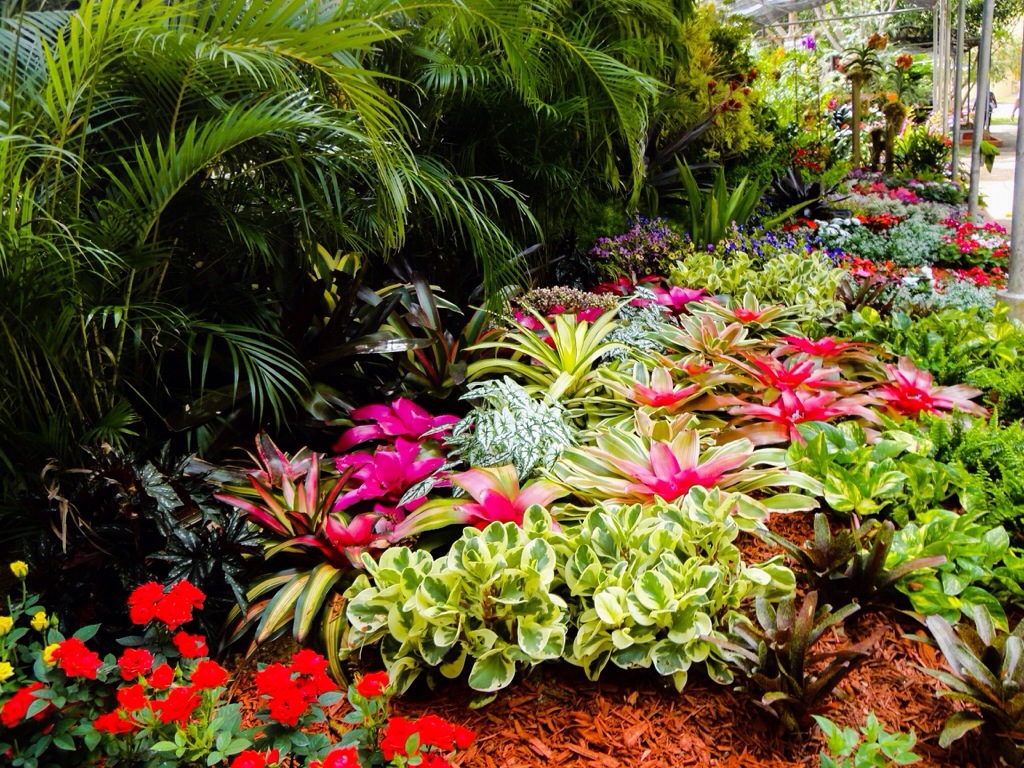 Aibonito (ei-bo-NEE-to) is known as “the garden of Puerto Rico” and the “city of flowers”. Aibonito is known for its poultry industry as well as its flowers and ornamental plants. The patron saint is Saint Joseph, although the patron saint’s festival is dedicated to St. James the Apostle, and held around July 25. Traditionally the festivities include low Mass, ringing of bells, fireworks, contests, lanterns and charanga music.
Aibonito (ei-bo-NEE-to) is known as “the garden of Puerto Rico” and the “city of flowers”. Aibonito is known for its poultry industry as well as its flowers and ornamental plants. The patron saint is Saint Joseph, although the patron saint’s festival is dedicated to St. James the Apostle, and held around July 25. Traditionally the festivities include low Mass, ringing of bells, fireworks, contests, lanterns and charanga music.
The aiboniteños are proud of the natural beauty of their town, which makes it attractive for tourists, particularly the San Cristóbal Canyon, and the annual flower festival.
Aibonito is located is located next to the Cayey range, and its elevation of 2,401 feet above sea level makes it the highest town in Puerto Rico. The pleasant climate of the town is due to this elevation, as well as the lowest recorded temperatures on the island. This is why the town is known as “the coldest city”, “the refrigerator of Puerto Rico” and the “Switzerland of Puerto Rico”.
The municapality which is situated in the central south mountainous region of the island, is bordered on the north by Barranquitas and Cidra, on the south by Salinas and Coamo, on the east by Cidra and Cayey, and on the west by Coamo. The mountainous terrain reaches up to the central mountain range. The highest elevations are to the south, the center and the west of the town.
Geographically, Aibonito features to the south and to the north of Puerto Rico can be seen from the mountains of Aibonito such as Dead Man’s Chest Island. The San Cristóbal Canyon is located between Aibonito and Barranquitas. The Canyon has many pools, abundant vegetation, waterfalls and many cliffs. The white clay in Aibonito is used for pottery.
Manufactured products include radiators and medical and surgical equipment. Medical services, the District Court and District Attorney’s office, a produce distribution warehouse and financial cooperatives are also important economic activities.
Foundation:
Don Manuel Vélez founded Aibonito on March 13, 1824. Aibonito is derived from the Taíno Jatibonuco language which means “river at night”. This territory once belonged to the Villa de Coamo and was known as Laybonito, later Aybonito and finally Aibonito. A legend also says that the name “Aibonito” is derived from the story of a Spanish musketeer admiring the Asomante Mountain and inspired by the beauty of the place exclaimed, “¡Ay, que bonito!” (Oh, what beauty!).
The first catholic church in Aibonito was constructed in 1825. It burned down in 1887 and was replaced by the present church finished in 1897.
Aibonito is the first municipality in organizing a festival dedicated to the flowers, celebrated since 1969. The Festival of the Flowers is celebrated every July. It is considered the most important event dedicated to the island flowers.
Location:
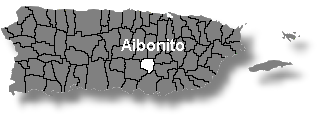 Aibonito is located in the Central Mountain Range. Bordering it are: Barranquitas and Cidra to the north, Salinas and Coamo to the south, Cidra and Cayey to the east, and Coamo to the west.
Aibonito is located in the Central Mountain Range. Bordering it are: Barranquitas and Cidra to the north, Salinas and Coamo to the south, Cidra and Cayey to the east, and Coamo to the west.
Area:
81.6 sq km / 31.4 sq mi
Population:
26,493 (census 2000)
Population Density:
324.6 per sq km / 843.7 per sq mi
People are known as:
Aiboniteños
Aibonito is also known as:
La Ciudad de las Flores (City Of Flowers)
La Ciudad Fría (The Cold City)
El Jardín de Puerto Rico (Puerto Rico’s Garden)
La Nevera De Puerto Rico (Puerto Rico’s Refrigerator)
Wards: Aibonito, Puerto Rico
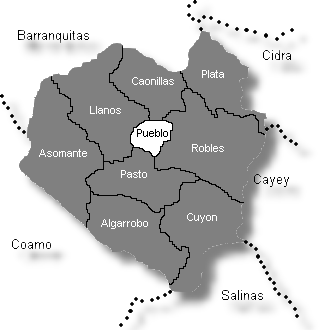
| Censo 2000: Population by Wards – Aibonito |
Habitants |
| Aibonito Pueblo | 3,662 |
| Algarrobo | 431 |
| Asomante | 2,787 |
| Caonillas | 1,402 |
| Cuyón | 873 |
| Llanos | 6,921 |
| Pasto | 3,988 |
| Plata | 1,863 |
| Robles | 4,566 |
| Total | 26,493 |
Información: Negociado del Censo de los EE.UU. Censo 2000
Patron:
San José
San José Parish
Apartado 2038
Aibonito, P.R. 00705
(787) 735-3741
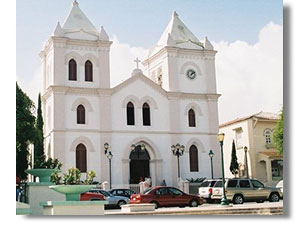
Topography:
Geographically, Aibonito belongs to the Mountain Range of Cayey (Sierra de Cayey). The terrain is precipitous and subject to erosion. Aibonito is the highest municipality of Puerto Rico, reaching 2,401 feet above sea level. It contains the following mountains: La Sierra (2,394 feet), the Torre Degetau (2,109 feet), and the Asomante (2,042 feet). From this point the bay of San Juan and the Island of Caja de Muertos can be seen.
Hydrography:
The Cuyon, Aibonito, Usabon and La Plata rivers are part of the hydrographic system.
Climate:
Average temperature is 75º farenheit, but temperatures in the 40s have been registered. The average annual rain is 90 inches.
Economy:
Agriculture at the present time is minimal with mainly flowers, some tobacco and coffee. Part of the land is dedicated to pasture for cattle production. This municipality has deposits of white clay or kaolin used in pottery and ceramics. It also has some industrial facilities manufacturing clothing, tapestry and furniture.
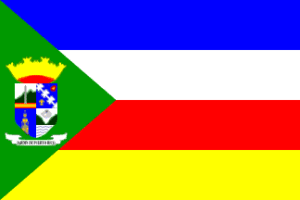
Flag:
The flag is ditinguished by its colors: blue for the sky, white for air purity, red for love of the motherland, and gold (yellow) for the traditional Hispanic values. The set of colors also stands for the transition from the Spanish era to the present one. At the center of the equilateral green triangle is the Coat of Arms of the Villa of Aibonito.
Coat Of Arms:
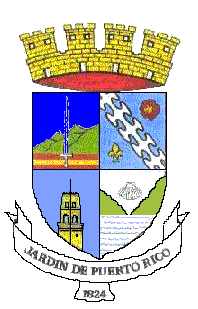 The shield is divided in four corners or quarters. The superior left corner represents the Asomante where last battles of the Hispano-American War took place, symbolized by the sword, reproducing in the base the national colors of Spain which stand for tradition and the inherited culture.
The shield is divided in four corners or quarters. The superior left corner represents the Asomante where last battles of the Hispano-American War took place, symbolized by the sword, reproducing in the base the national colors of Spain which stand for tradition and the inherited culture.
In the right corner we find: a white band symbolizing the fog that covers the Aiboniteños valleys and mountains in winter; on a blue field, a purple color flower typical of the region and declared official by the organizers of the First Festival of the Flowers in 1969; and in the inferior end a golden lily to remember San José, patron of the Parochial Church of the town and also symbolizing the Eminence Cardinal Luis Aponte Martinez, first Puerto Rican Cardinal of the Catholic Church. He was the priest for the Aibonito Parish between the years 1957 and 1961.
In the inferior part of the shield, upon the left corner on a blue background is placed the gold tower of the Manresa House to symbolize the spiritual value that such institution represents for all Puerto Rico. In the right corner a divided mountain of green color which represents the San Cristóbal Canon with a seashell in the superior part that symbolizes Apostle Santiago in whose honor, since inmemorables times, the “Patron Festivities” have been celebrated when the artisans of the town chose a symbolic “king” to whom the Mayor gives the keys of the city. In the base there are blue and white waves that represent the aquatic wealth. The banner “Jardín de Puerto Rico” (Garden of Puerto Rico) recalls the popular characteristic of Aibonito noted for its gardens, flowers and plants and declared official of Aibonito by the organizers of the First Festival of the Flowers in 1969. In the inferior end of the flower a golden lily remembers San José, patron of the Parochial Church of the town and also symbolizes the Eminence Cardinal Luis Aponte Martinez, first Puerto Rican Cardinal of the Catholic Church. He was the priest for Aibonito between the years 1957 and 1961.
In the inferior part of the shield, left corner on a blue background the tower of the Manresa House, in gold, to symbolize the spiritual value that such institution represents for all of Puerto Rico. In the right corner a divided mountain of green color which represents the San Cristóbal Canon with a seashell in the superior part that symbolizes Apostle Santiago in whose honor, since time immemorable the “Patron Festivities” have been celebrated when the artisans of the town chose a symbolic “king” to whom the Mayor gives the keys of the city. In the base there are blue and white waves that represent the aquatic wealth. The banner “Jardín de Puerto Rico” (Garden of Puerto Rico) recalls the popular characteristic of Aibonito noted for its gardens, flowers and plants.
Places To Visit:
- San Cristóbal Canyon
- Casa Manresa
- Angel Roberto Ortiz Cultural Center
- Spanish Barracks
- Our Lady of the Forsaken Hermitage
- Saint Joseph’s Catholic Church
- Degetau Rock
- Monta’ Rock
- Asomante Trench
Events:
- Festival de la Chapita (bottlecap batting) – April
- Bamboo Bat and Rubber Ball Festival – Summer
- Flower Festival – June/July
- Patron Saint’s Festival, Saint James the Apostle – July
- Turkey Marathon – November
- Festival of the Mountains – November
Distinguished Citizens:
- Manuel Alvarez-Nazario – college teacher and philologist. He was a member of the Puerto Rico Academy of the Spanish Language. His publications include El arcaísmo en el español de Puerto Rico (1951), El influjo indígena en el español de Puerto Rico (1977), Proceso en el tiempo del español en Puerto Rico (1980), among others.
- Rubén Berríos-Martínez – attorney, college teacher, political figure, and president of the Puerto Rico Independence Party. He has run for governor several times (1976, 1980, 1988, 2000 and 2004) and was a Senator-at-large in 1973 – 1976, 1985 – 1988 and 1993 – 2000. Berrios was awarded the Medal of the Puerto Rico Atheneum on October 19, 2001.
- Leonardo González-Rivera – athlete. Appointed Secretary of the Department of Recreation and Sports in 1985, Gonzalez was president of the Puerto Rico Boxing Commission for two years (1988 – 1990).
- Josefina Guevara-Castañeira – journalist and writer. Her works include Del Yunque a los Andes (1959), Los encadenados (1966), La otra voz (1973), among others.
- María Guevara-Marrero – composer. Her compositions include the anthem of Aibonito, Bajo el cielo de Aibonito.
- José Conrado-Hernández – doctor of theology and attorney. Under Spanish rule Conrado was a judge and prosecutor. After the American invasion, he was justice of the Supreme Court, becoming chief justice in 1909.
- Juan Martínez-Capó – story-writer, literary journalist, poet, editor, essayist, and critic. Martinez wrote the columns “Escena literaria” and “Libros de Puerto Rico” for the now defunct newspaper El Mundo. He directed the University of Puerto Rico Press from 1986 to 1988.
- Rafael Pont-Flores – educator, journalist, and athlete. Pont directed the Escuela magazine at the Department of Education. As a sports chronicler, he was appointed to the Puerto Rico Sportswriters Hall of Fame. He collaborated with newspapers such as El Mundo, El Imparcial and El Nuevo Día and published works such as El deporte en broma y en serio (1951) and Un puertorriqueño en España (1969).
Hymn:
By Santa Guevara Marrero
Aibonito, Aibonito, Aibonito
donde vieron mis ojos la luz
son tus flores las flores más bellas
y tu cielo más puro y azul
Te recuerdo con mucho cariño
nunca, nunca te podré olvidar
Aibonito, Aibonito, Aibonito
eres tú mi pueblito ideal.
Aibonito mi pueblo querido
donde todo es belleza y bondad,
recordando tus lindos paisajes
me embarga la felicidad.
Dios Bendiga mi pueblo tan lindo
Aibonito, mi pueblo natal
tu belleza es incomparable
y tu clima que no hay otro igual.
Public Schools sorted by educational levels.
Caguas Región
Aibonito Distict
| Name | Level | Telephone | Address |
| Elementary | |||
| FEDERICO DEGETAU II | 5-6 | (787) 735-7628 | PO Box 2139, P.R. 00705-0000 |
| LLANOS ADENTRO | K-6 | (787) 735-6396 | PO Box 970, P.R. 00705-0000 |
| RABANA | K-6 | (787) 735-8886 | PO Box 1269, P.R. 00705-0000 |
| ROSARIO BELBER | EE | (787) 735-5875 | PO Box 2041, P.R. 00705-0000 |
| SUCESIÓN TORRES | K-6 | (787) 735-7736 | PO Box 1269, P.R. 00705-0000 |
| Intermediate | |||
| RAFAEL PONT FLORES | 7-9 | (787) 735-4571 | PO Box 1269, P.R. 00705-0000 |
| Secondary | |||
| SU JOSÉ CELSO BARBOSA | K-9 | (787) 735-8892 | PO Box 2300 Suite 34, P.R. 00705-0000 |
| SU LA PLATA (CARMEN ZENAIDA VEGA) | K-9 | (787) 735-8801 | PO Box 161, P.R. 00786-0161 |
| SU PASTO | K-9 | (787) 735-8158 | PO Box 1211, P.R. 00705-0000 |
| High School | |||
| BONIFACIO SÁNCHEZ JIMÉNEZ | 10-12 | (787) 735-0232 | PO Box 538, P.R. 00705-0000 |
| DR. JOSÉ N. GANDARA | 10-12 | (787) 735-7290 | PO Box 1269, P.R. 00705-0000 |

